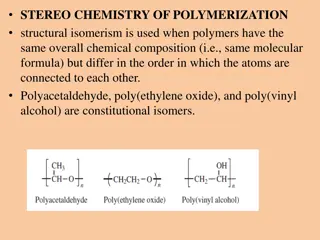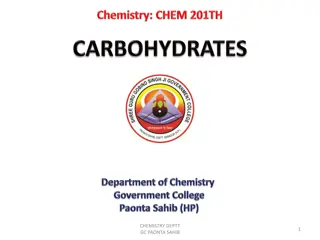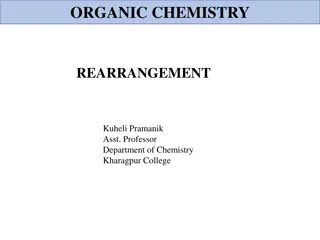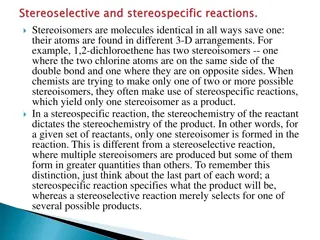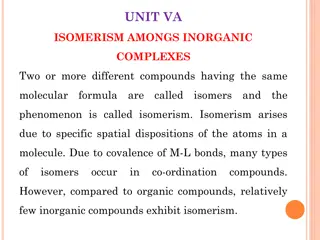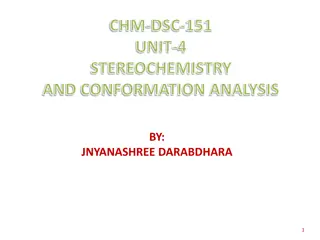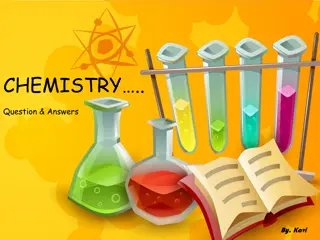Stereochemistry and Isomerism in Polymerization
Structural isomerism plays a crucial role in polymer chemistry by distinguishing polymers with the same molecular formula but different atom connectivity. Isomeric polymers can stem from different monomers or polymerization routes, resulting in variations in properties. Stereoisomerism, on the other
1 views • 36 slides
Epimerisation of D-Glucose into D-Mannose: Structural Insights
Explore the fascinating process of epimerisation, specifically the conversion of D-glucose into D-mannose. Discover the limitations of open chain structures, the ring structure of glucose, and the evidence supporting it. Learn about the stereochemistry of D-glucose, optical rotation, and the equilib
0 views • 13 slides
NMR Applications in Organic Chemistry Research
NMR (Nuclear Magnetic Resonance) is a powerful technique used in organic chemistry research for a wide range of applications, including structure elucidation, identification of small molecules, quantitative analysis, and studying dynamics. Through various NMR experiments, researchers can determine s
1 views • 13 slides
Understanding Tetracyclines: Antibacterial Agents in Pharmaceutical Chemistry
Tetracyclines, a group of broad-spectrum antibiotics, play a vital role in pharmaceutical chemistry. This article delves into the complex stereochemistry, structures, and reactivity of tetracyclines, highlighting their importance in combating bacterial infections. Explore the unique characteristics
0 views • 25 slides
Understanding Stereochemistry: Isomers and Their Properties
Stereochemistry explores the fascinating world of isomers, including stereoisomers, geometric isomers, and structural isomers. Stereoisomers have the same molecular formula but differ in spatial arrangement, while geometric isomers lack free rotation around bonds. Structural isomers like dimethyl et
0 views • 27 slides
Hofmann Rearrangement: Mechanism, Stereochemistry, and Key Steps
The Hofmann rearrangement is a notable organic chemistry reaction that converts an amide into an amine with one less carbon atom. This process involves key steps such as bromination of nitrogen, extraction of H+ by OH-, and rearrangement of anion. The mechanism includes the formation of N-Bromoamide
6 views • 15 slides
Understanding Stereospecific and Stereoselective Reactions in Organic Chemistry
Stereoisomers are molecules that differ only in their 3-D arrangements, with stereoisomers having identical atoms but different spatial orientations. Chemists utilize stereospecific reactions to produce only one stereoisomer, determined by the reactant's stereochemistry. Conversely, stereoselective
5 views • 33 slides
Understanding Tetracyclines: Antibiotics in Pharmaceutical Chemistry
Tetracyclines are a vital group of broad-spectrum antibiotics with complex stereochemistry, structural characteristics, and reactivities. Researchers have developed more stable derivatives such as methacycline, doxycycline, and minocycline to address unfavorable reactions. These compounds play a cru
4 views • 22 slides
Isomerism in Inorganic Complexes: A Comprehensive Overview
Isomerism in inorganic complexes is a fascinating phenomenon arising from the specific spatial arrangements of atoms within molecules. This article delves into the types of isomerism found in coordination compounds, such as structural isomerism and stereoisomerism. The importance of studying isomers
0 views • 67 slides
Stereochemistry and Conformation Analysis in Organic Molecules
This material discusses stereochemistry concepts such as saw-horse projections, Newman and Fischer representations, and conformational analysis of organic molecules. It covers different types of configurations and rotations around carbon-carbon bonds, emphasizing the importance of understanding spat
0 views • 16 slides
Understanding Organic Chemistry Reactions: Electrophilic Addition, Stereochemistry, and Neighbouring Group Participation
In organic chemistry, different types of reactions play a crucial role in modifying compound structures. Electrophilic addition involves breaking bonds to form new ones, stereo specific reactions yield specific stereoisomers, and nucleophilic addition reactions break bonds by reacting with nucleophi
0 views • 21 slides
Insights into Transition Metal Catalyzed Olefin Polymerization Mechanisms
Detailed exploration of transition metal catalyzed olefin polymerization via coordination-insertion mechanism, including the use of Ziegler-Natta catalysts, MAO activators, and stereochemical control of poly-1-alkenes. The mechanism, catalyst types, activators, and stereochemistry effects are discus
0 views • 19 slides
